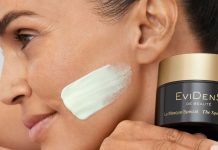September is almost here, and if for some, it marks the beginning of a new academic year, for many, it brings skin issues because of its tricky weather. The autumn, a time for changing leaves, red sunsets and warmer clothes calls for skincare adjustments because as soon as the temperature drops, the skin needs special care to counteract its effects. Breakouts, dryness, tightness, and pigmentation are only some of the issues you can experience once the season changes.

A Pinterest report reveals that beauty routine searches spike once the summer reaches its end because hot weather takes a toll on your skin triggering inflammation, dehydration and excessive tanning. The sudden drop of temperature can influence the way your skin looks, feels and performs.
The autumn impairs the skin barrier making it more fragile, and you can manifest symptoms like sensitivity, dryness, and redness. Think of your skin barrier like a raincoat that protects your body from outside factors. When the weather breaks it, external factors like pollution cause inflammation, redness, and sensitivity. Through your skincare routine, you can stop the cold from overwhelming your skin.
Here are some switch-ups to make before the temperatures drop.

Use a moisturising cleanser
During fall, temperatures plummet and so do humidity levels, so you need to extra moisturise your skin to make up for the dryness in the air. The first step is to swap from your light summer cleanser to a more moisturising one. If you didn’t use micellar cleansing water before, add it to your daily routine because it can hydrate even sun-scorched skin. Micellar water is great because it supports the skin barrier that is fragile when the temperatures drop and protect it from the damaging effects of the cold weather.
When you buy face cleanser, pick one with extra moisturising properties to clean the skin and remove the feeling of tight or dry skin. Cleansing your face in the morning and evening is essential to keep it clean from dirt accumulated during day or night. The skin’s natural cell turnover process generates debris in the upper layer, and to remove it, you must use a cleanser. Plus, when rubbing the skin with the product, you stimulate the blood flow and aid the derma to eliminate toxins.
Use a moisturiser to rebuild the skin barrier
To repair and reinforce the damaged skin barrier, you need to hydrate your skin with a product rich in lipids and ceramides. Not all creams and lotions include the right amount, so reading a skin care review for the products you have on your list to try can help you determine if they fit your needs. A cream with ceramides and lipids prevents moisture loss and retains hydration.
Using a product with a whipped cream texture over a hyaluronic acid serum creates a protective layer on top of the skin that prevents water from escaping and creates a cushion against harsh temperatures.
Even if you have an acne-prone or oily skin, you must use a moisturiser daily. It’s best to pick products rich in water with no oil in the ingredients to stop the skin from producing extra oil. They keep the skin supple, hydrated and prevent damaging factors from clogging into your derma. Meanwhile, if you have dry skin, go with a product rich in nutrient oils, especially at night.
Swap the summer moisturiser for a richer alternative

Now that you cleansed and soothed your post-summer skin, you must build your skin’s barrier before even harsher temperatures hit. We mentioned it in the above paragraph, but we cannot stress enough how vital a rich moisturiser is for your skin during the colder seasons. By adding a creamy moisturiser to your daily routine, you help your skin face the changing temperatures.
If you have oily skin, you may love using a light lotion, but not all rich creams clog your skin. If you pick one rich in water, it gives a boost to your skin and leaves it glowy and ready to face the changing seasons.
Your lips will be the first to feel the cold (be ready to welcome, flaky and chapped lips). But if you put a little of the lip moisturiser on your lips and then add a rick balm, you create a barrier against cold weather, and your lips will no longer look like the scales of a snake in the spring. Use a sugar scrub to remove dead skin cells before you buffer them with moisturiser.
Exfoliate
Your post-summer skin needs a peeling treatment to remove dead cells and leave it radiant and fresh. Head to your local beauty clinic to perform a deep exfoliation. If you prefer home treatments, a blend of alpha-hydroxy acids like glycolic or lactic dissolves dead cells and reveals healthy glowing skin.
Daily exfoliate your skin with a mild chemical exfoliant. Stay away from physical scrubs if you exfoliate daily because they can tear micro-fissures in the skin and damage the barrier already deteriorated by harsh weather. Lactic acid is a product that exfoliates and hydrates at the same time. It also removes pigmentation and revives skin radiance lost because of sunburns.
Add retinol to your skincare routine
Now that sun is hidden behind the clouds; you can use retinol to care for your skin. Vitamin A makes your skin more sensitive to the sun, and it’s best to avoid it during summer. But now that the cold season comes, you can add it again to your skincare routine. Retinol is fantastic at boosting cell growth, regulating oil flow, and improving skin appearance, especially if you experience pigmentation.
Add it slowly to your daily routine to determine its tolerance to Vitamin A. Once sure it doesn’t trigger side effects use it every night before going to bed.
Don’t give up on SPF

Only because the sun doesn’t shine as bright as during the summer, it doesn’t mean you can wave bye-bye to SPF products. UV rays can damage your skin all year round, so SPF isn’t a product you can remove from your routine. During the cold seasons pick a lighter one, that allows your skin to breathe.











